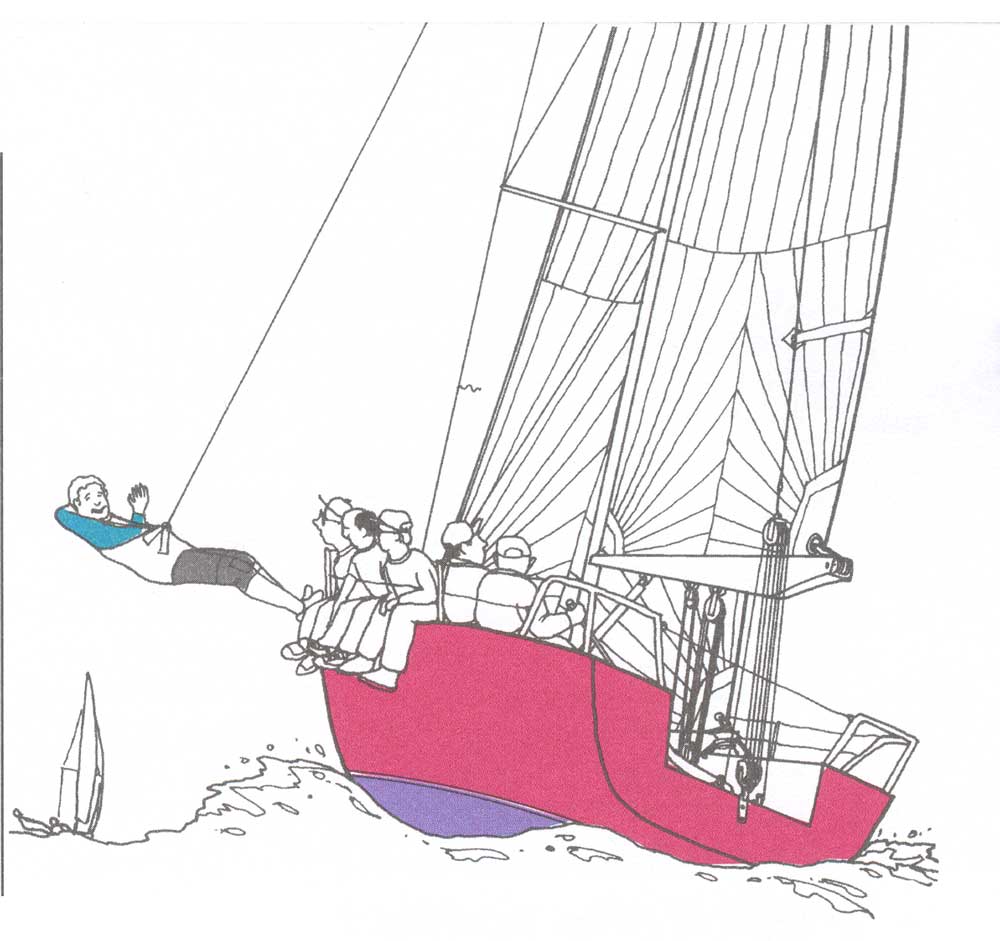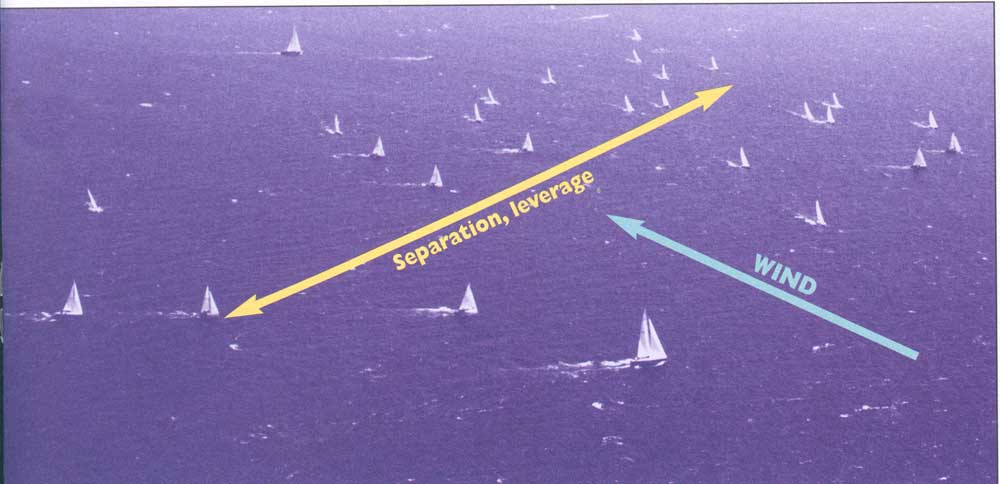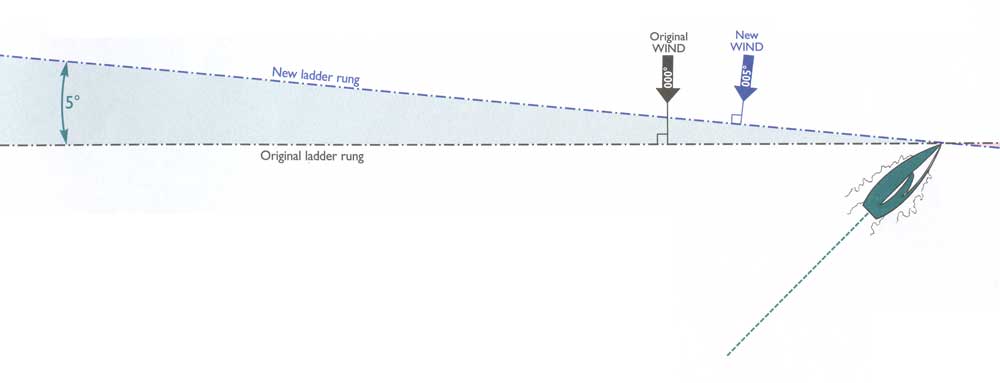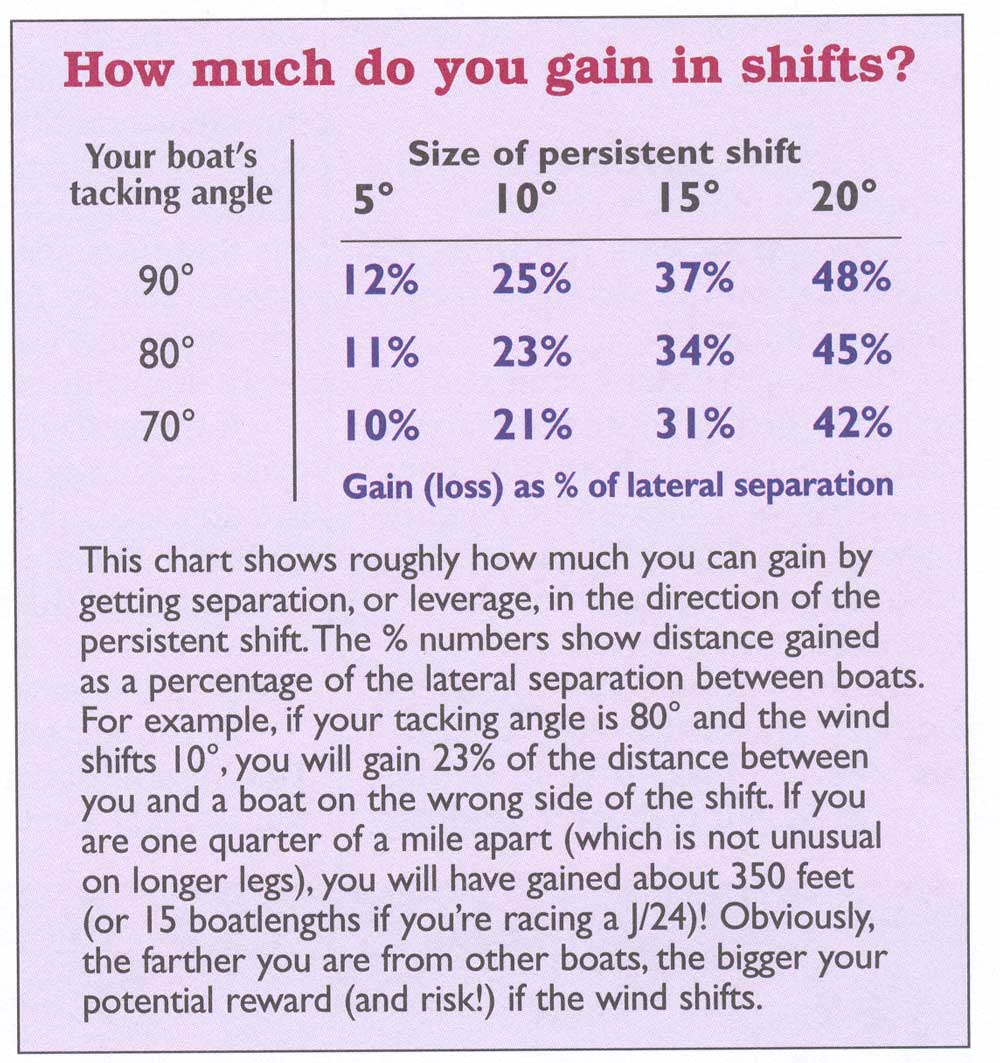by David Dellenbaugh
It’s hard to talk about windshifts without considering the subject of “leverage.” Leverage is what you get when you sit on the edge of a seesaw, stand at the end of a diving board, or use a trapeze wire to hang out over the side of a boat.
In the realm of strategy and tactics, leverage is a boat’s potential to gain or
lose when the wind changes direction. It’s essentially a function of the lateral
distance between boats across a race course. The farther apart two boats are,
the more leverage they have on each other, and vice versa.
Knowing the geometry of leverage is very important for understanding how much
distance you could gain or lose as the result of even a small windshift. A good
rule of thumb is that for every 5 degree change in wind direction you will gain
or lose roughly 10% of the lateral distance between you and other boats. You’ll
gain on every boat that is farther away from the shift than you, and you’ll lose
to every boat that is closer.
For example, let’s say you are racing up the first beat and your toughest
competitor is even with you in the race, but 20 boatlengths to your right. Now
suppose the wind shifts 5 degrees to the right (in his favor). You have just
lost about 10% of 20 lengths, so you are roughly two lengths behind him.
 |
| Lev er age n. 1. mechanical power resulting from the action of a lever; 2. increased means of accomplishing some purpose. |
The Nature of Leverage
Leverage is especially important whenever the wind is shifting persistently
because this wind does not return to a median direction, so gains and losses are
more ‘permanent’ than with oscillating shifts. In addition, persistent shifts
are often larger and occur when boats are spread far apart.
 |
| “Leverage” is the lateral separation between boats on the race course. By lateral, we mean the amount of separation in a direction that is roughly perpendicular to the wind. If one boat is directly upwind of another, neither has any leverage. In this photo, however, the fleet is pretty spread out. The boats on each side of the course have quite a bit of separation from boats on the other side of the course. |
When the wind shifts (persistently or otherwise), the amount of distance you
gain or lose is roughly proportional to two things:
1) The lateral separation between boats.
If a boat that is 20 lengths away gains 2 lengths in a windshift, a boat that is
40 lengths away will gain 4 lengths in the same shift. If you have a tiny
persistent shift of just one degree (which is almost impossible to measure), a
boat that is 100 feet away will gain only about 2 feet, but a boat that is half
a mile away in the other corner of the beat will gain more than 60 feet!
2) The size of the windshift.
If one boat gains 4 boatlengths on another in a 10 degree shift, the same boat
will gain 8 lengths in a 20 degree shift.
When you combine the potential separation between boats on a long beat or run
with persistent shifts that are commonly as much as 10 degrees or 20 degrees,
it’s obvious you can gain or lose a lot by getting leverage.
The tactics of leverage
Having a lot of leverage on, or separation from, other boats is not necessarily
good or bad - it depends on a lot of factors. Perhaps the most important is the
concept of risk and reward.
While you are racing, it’s always good to ask yourself one question: Am I happy
with my position in this race? If your answer is yes, you shouldn’t take much
risk. If you answer no, then you would normally be willing to take more of a
risk to improve your position.
 |
 |
One way to increase your risk (more chance to gain, but also more chance to
lose) is by increasing your leverage. For example, you might split from the
boats ahead and sail toward the opposite side of the beat. Similarly, if you
want to minimize risk, you should reduce leverage and stay near the fleet.
Leverage is closely related to the idea of ‘covering.’ When you want to stay
ahead of another boat, you should cover them tightly, usually by staying
directly to windward of them. That way they don’t have any leverage on you, and
you won’t risk losing much distance if the wind shifts.
 |
When you’re behind and you need to pass another boat, try to break their cover
by getting away from them. The farther ahead of you they are, the more
separation, or leverage, you need inorder to have a chance to gain enough to
catch them. Obviously, it’s better to get leverage (or prevent other boats from
getting leverage on you) in the direction of the next windshift.
Dave publishes the newsletter Speed & Smarts. For a subscription call:
800-356-2200 or go to:
www.speedandsmarts.com
All contents are copyright (c) 2006 by Northern
Breezes, Inc. All information contained within is deemed reliable but carries no
guarantees. Reproduction of any part or whole of this publication in any form by
mechanical or electronic means, including information retrieval is prohibited
except by consent of the publisher.